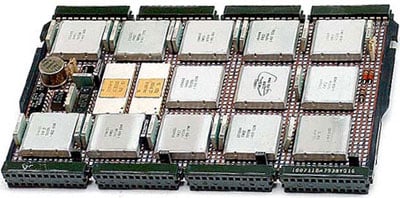
Five Facts about Portable Computer
- Portable computers typically have modest technological features and are inexpensive.
- In September 1975, IBM released the 5100. It weighed 55 pounds, making it significantly lighter and more portable than any previous computer.
- In April 1981, a company called Osborne, driven by a journalist turned entrepreneur named Adam Osborne, produced the first portable computer.
- The power utilized by a portable computer is lower than that of a desktop computer, which can aid with power and cost savings.
- The pricing of the Osborne 1 was especially appealing because it came with $1,500 worth of productivity software.
Portable Computer History
The Osborne 1 was the first commercially successful portable computer made by the Osborne Computer Corporation, and it was released on April 3, 1981. The portable computer is powered by a wall socket and runs on the CP/M 2.2 operating system.
Lee Felsenstein designed Osborne 1, and Adam Osborne developed it. Before creating the Osborne 1 computer, Osborne was a computer book author. The Osborne 1 was based on the Xerox NoteTaker, a prototype built by Alan Kay in 1976.
The Xerox NoteTaker, developed at Xerox PARC in 1976, was a forerunner to later portable computers from Osborne Computer Corporation and Compaq; however, it remained a prototype and never saw production.
SCAMP (Special Computer APL Machine Portable) was a portable computer prototype built by IBM Palo Alto Scientific Center in 1973, based on the IBM PALM CPU. It included a Philips compact cassette drive, a small CRT, and full function keyboard. To run APL1130, SCAMP simulated an IBM 1130 minicomputer. Unfortunately, APL was only accessible on mainframe computers in 1973, and most desktop microcomputers, such as the Wang 2200 or HP 9800, only offered BASIC.
Following successful demonstrations of the SCAMP prototype in 1973, IBM released the first commercial IBM 5100 portable microcomputer in 1975. Engineers, analysts, statisticians, and other business problem-solvers could use the device, which included an IBM PALM processor, 5-inch (130 mm) CRT, full-function keyboard, and the ability to program in both APL and BASIC.
(IBM offered many models of the 5100 that supported only BASIC, only APL, or both, depending on which physical switch on the front panel was used.) The 5100 Portable Computer was IBM’s first production personal computer, released in September 1975, six years before the best-seller IBM PC. Engineers, analysts, statisticians, and other problem-solvers may use the 5100 to put computer skills at their fingertips, but not for business.
If the IBM 5100’s size and weight (25 kg) seem large by today’s standards, consider how little it was compared to a late-1960s IBM computer with comparable capabilities. A machine of this size and weight would have been roughly the size of two desks and weighed around half a ton.
The 5100 was significantly more potent than its predecessors, such as the Altair 8800 (but also considerably more expensive—it cost between $8975 and $19975). It had a CRT display, keyboard, BASIC interpreter, and mass storage built-in (tape drive). It also features a considerably more sophisticated design: An interpreter that understands a subset of the IBM 360 (or IBM/3) mainframe instruction set! A microcode 16-bit CPU was executing an interpreter!
Portable Computer: How It Worked
The PALM processor was a large circuit board populated with over a dozen chips. IBM referred to it as a microprocessor, but they meant a processor that executes microcode to implement a higher-level instruction set, rather than the traditional definition of a complete processor on a single silicon integrated circuit. Such a machine would have been approximately the size of two desks and weighed around half a ton in the late 1960s (0.45 t). The IBM 5100, on the other hand, weighed about 53 pounds (24 kg and was very portable for that time).
The 5100 has a five-inch internal CRT that shows 16 lines of 64 characters. Because the characters are so minor, IBM included a three-position switch that allows the user to choose whether to see all 64 characters per line or just the left or right 32 characters (interspersed with spaces). IBM 5100 used a 1/4-inch cartridge tape drive with DC300 cartridges to store 204 KB on 300 feet of tape for mass storage. A toggle switch on the front panel determined the user’s preferred language on a 5100 with both languages (APL and BASIC).
The 5100’s language interpreters (APL and BASIC) are designed for more advanced virtual machines, and the microcode emulates those machines rather than being written in the processor’s native microcode instruction set. This was done to save on the amount of ROM (read-only memory) required to implement the language interpreters and speed up software development. The BASIC microcode emulates System/3, while the APL microcode emulates a part of the System/360 instruction set.
With the IBM 5100, IBM provided three Problem-Solver Libraries, including more than 100 interactive routines relevant to mathematical issues, statistical approaches, and financial studies.

Portable Computer: Historical Significance
Unlike other mobile computing devices or laptops, Portable computers use conventional motherboards and have plug-in slots for add-on cards. As a result, portable computers also have a distinct advantage over desktop computers in portability and flexibility of use.
Compared to desktop computers, portable computers are smaller and take up less space. The power utilized by a portable computer is lower than that of a desktop computer, which can aid with power and cost savings. In comparison to desktop computers, portable computers have a greater sense of immediacy.